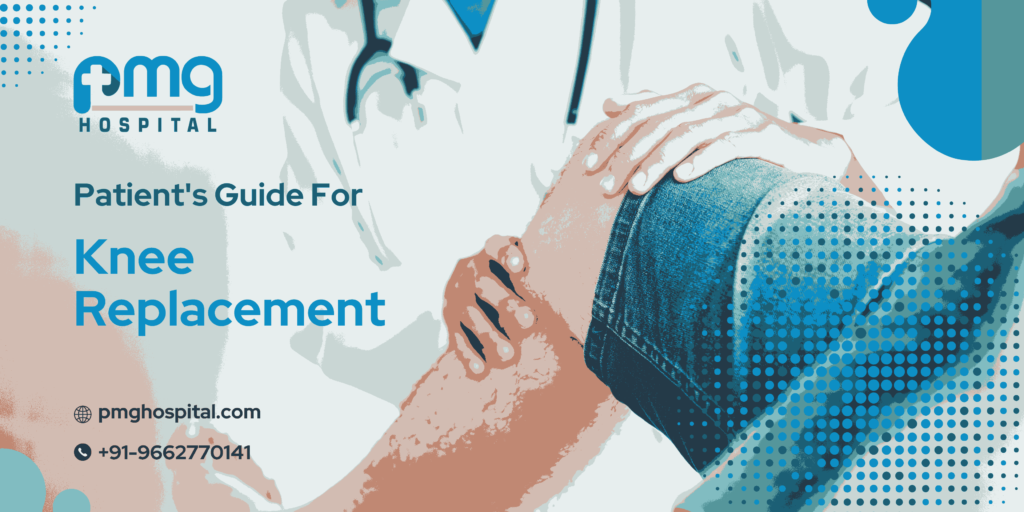As the largest joint in the body, our knees perform most of our daily tasks. This joint consists of three bones: the thigh, the knee cap, and the shin.
There’s a chance you’ll get an injury or develop a disease like arthritis. Simple things like walking, climbing stairs, or getting out of bed are challenging in these cases.
The doctor suggests nonsurgical interventions like medication, physiotherapy, cortisone shots, limiting motion, and even weight loss. When none of these treatments work, a doctor may recommend Knee Replacement Surgery.
A knee replacement was performed for the first time in 1968.
The procedure has become more effective in recent decades because of advances in surgical materials and techniques. A total knee replacement is considered one of the most successful surgical procedures in medical history.
However, this patient’s guide gives you much more information about Total Knee Replacement, whether you’re just starting to look at treatment options or have already decided to have one.
Total Knee Replacement Surgery: A Quick Overview
Knee replacement surgery, or knee arthroplasty, restores the surface of a knee damaged by arthritis. The kneecap, made of plastic and metal, is an intricate part of the knee joint. A person with severe arthritis or knee injury may benefit from this surgical procedure.
Knee joints can be affected by different forms of arthritis. The degenerative joint disease osteoarthritis, which is more common in middle-aged and older individuals, can damage knee cartilage and bones. An inflamed synovial membrane and excessive synovial fluid may cause rheumatoid arthritis to cause pain and stiffness.
Injury-induced arthritis, also known as traumatic arthritis, can damage the cartilage in the knee. Resurfacing damaged knee joints is the primary goal of replacement surgery, as it alleviates pain and resurfaces the damaged joint.
What Causes Knee Pain?
Here Are Some Knee Pain Symptoms:
- Walking is hard
- Knee instability
- Legs feel shaky
- Unbending knees
- Swelling and redness
- Knee cannot extend fully
Critical Reasons For Knee Joints Pain
Arthritis is to blame for most chronic knee pain and disability. Many types of arthritis cause knee pain, but osteoarthritis, rheumatoid arthritis, and post-traumatic arthritis are the worst.- Osteoarthritis
- Rheumatoid arthritis.
- Post-traumatic arthritis.
Knee Replacement Surgery: Risks And Benefits
The benefits of knee replacement surgery often outweigh the potential risks. If you are looking for long-term pain relief and a more active, healthier lifestyle, undergoing a total knee replacement can be a beneficial option. While complications are rare, there is a risk of blood clots, deep vein thrombosis, and infections after surgery. Additionally, those taking blood thinners may experience uncontrolled bleeding. Consulting an orthopedic surgeon in Ahmedabad can help you understand the procedure, its benefits, and how to minimize risks for a successful recovery.
Overall, there is a low rate of major complications following total knee replacement surgery, and patients report significant improvements in their mobility and pain following this procedure. Your knee surgery risk depends on your knee problem’s complexity and health. Knee replacement surgeries have risks and benefits, so you should be aware of both. Knowing what will happen to your knee pain if you don’t have surgery is essential.
Make sure you research before your appointment to ask your orthopedic surgeon the appropriate questions.
Do You Need A Knee Replacement Operation?
The Right Time For Knee Replacement Surgery
Several factors may lead your doctor to recommend knee replacement surgery. People with these conditions often benefit from knee replacements:- Having trouble walking, climbing stairs, or getting in and out of a chair due to severe knee pain. You may need a cane or walker when you can’t walk more than a few blocks without getting hurt.
- Pain in your knees while you’re sleeping or resting.
- Inflammation and swelling in the knees that can’t be treated with rest or pills
- Knee deformity – bending or bending the knee
- The condition isn’t improving with other treatments like anti-inflammatory drugs, cortisone injections, lubricating injections, physical therapy, or surgery.
Potential Candidates For Surgery
The age or weight of a patient does not matter when it comes to having a knee replacement.
Patients are recommended surgery based on their pain and disability. It is usually recommended that patients between 50 and 80 undergo total knee replacements, but each case is evaluated on a case-by-case basis. From teenagers with juvenile arthritis to older people with degenerative arthritis, total knee replacements can be performed on any age group with a severe knee injury.
How Can You Expect Things To Turn Out In Knee Replacement Surgery?
- Before the procedure
Knee replacement surgery requires anesthesia. If you say yes to general anesthesia, you’re asleep; if you say no to spinal anesthesia, you’re awake but won’t feel pain. A team decides whether to use general or spinal anesthesia based on input and preferences.
The surgeon will give you an antibiotic before, during, and after surgery to prevent any possibility of infection. There’s also the chance you’ll need a nerve block to numb your knee. Following the procedure, the numbness slowly goes away.
- During the procedure
The surfaces of your knee joint will be exposed when your knee is bent. An incision of 6 to 10 inches (15 to 25 centimeters) is made to remove the damaged knee tissues.
The surgeon attaches surgical pieces to the joint surfaces after they’re prepared. When your surgeon closes the incision, they bends and rotates your knee to ensure it’s working. Surgical procedures take about two hours.
- After the procedure
Once you’re done with surgery, you’ll be taken to a recovery room for a few hours. Depending on your specific needs and recovery time, it varies from person to person. In some cases, the patients are discharged on the same day of the surgery whereas for others it might take longer. Controlling your pain should be easier with a prescription.
Moving your foot and ankle helps prevent swelling and blood clots because blood flows to your leg muscles. You’ll probably get blood thinners, and you might wear compression boots or a support hose to prevent swelling.
You’ll need to perform breathing exercises regularly and gradually become more active. Also, you will receive instructions from the therapist to perform the regular knee exercise to get recovered at ease.
Don’t skip your workouts. Follow your care team’s wound care, diet, and exercise recommendations.
Recovery Time After Knee Replacement – What To Expect?
Patients recovering from knee replacements need to set realistic expectations before starting this crucial stage of recovery. After surgery, you should elevate the knee to reduce swelling and pain.
Most people can walk and stand using crutches within a few days of the surgery. These crutches take a week or more to help you get back to regular leg movement after knee surgery. Following a knee replacement, you can usually return to work within a few weeks. After surgery, you should be able to start driving again in about a month.
You might be able to live an active, pain-free lifestyle after getting knee replacement surgery – a procedure that can solve mobility issues associated with knee osteoarthritis.
Our team at PMG Hospital – Best orthopedic surgical hospital in Ahmedabad is committed to keeping you in good hands throughout your total knee replacement surgery. As a leading orthopedic surgical center in Ahmedabad, Gujarat, we provide our patients with the highest level of medical care by utilizing advanced surgical equipment for total knee replacement.



